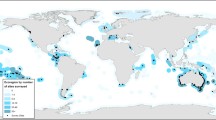Abstract
For an assemblage of fishes inhabiting a warm temperate, rock reef near San Diego, California (USA), a series of censuses were made based on frequency of occurrence and standard numerical counts. These data were then compared with a parallel study based on the rapid visual technique (RVT) of Jones and Thompson (1978). Because the RVT ranks abundances according to frequency of encounter and disregards variations in the spatial distributions of different species, the method overemphasizes the importance of widespread albeit rare fishes but under-emphasizes patchy although abundant species. The discussion considers the relative merits of the RVT method for characterizing assemblages of fishes on temperate rock reefs and on tropical coral reefs.
Similar content being viewed by others
Literature Cited
Alevizon, W. S. and M. G. Brooks: The comparative structure of two western Atlantic reef-fish assemblages. Bull mar. Sci. 25, 482–490 (1975)
Bevan, W., R. A. Maier and H. Helson: The influence of context upon the estimation of number. Am. J. Psychol. 76, 464–469 (1963)
Brock, R. E.: A critique of the visual census method for assessing coral reef fish populations. Bull. mar. Sci. 32, 269–276 (1982)
Brock, V. E.: A preliminary report on a method of estimating reef fish populations. J. Wildl. Mgmt 18, 297–308 (1954)
Ebeling, A. W. and R. N. Bray: Day versus night activity of reef fishes in a kelp forest off Santa Barbara, California. Fish. Bull. U.S. 74, 703–717 (1976)
Ebeling, A. W., R. J. Larson, W. S. Alevizon and R. N. Bray: Annual variability of reef-fish assemblages in kelp forests off Santa Barbara, California. Fish. Bull. U.S. 78, 361–377 (1980)
Ehrlich, P. R. and A. H. Ehrlich: Coevolution: heterotypic schooling in Caribbean reef fishes. Am. Nat. 107, 157–160 (1973)
Gaufin, A. R., E. K. Harris and H. J. Walter: A statistical evaluation of stream bottom sampling data obtained from three standard samplers. Ecology 37, 643–648 (1956)
Goldman, B. and F. H. Talbot: Aspects of the ecology of coral reef fishes. In: Biology and geology of coral reefs. Vol. III. Biology 2, pp 125–154. Ed. by O. A. Jones and R. Endean. New York: Academic Press 1975
Itzkowitz, M.: A behavioural reconnaissance of some Jamaican reef fishes. Zool. J. Linn. Soc. 55, 87–118 (1974)
Itzkowitz, M.: Social dynamics of mixed-species groups of Jamaican reef fishes. Behavl Ecol. Sociobiol. 2, 361–384 (1977)
Jones, R. S. and M. J. Thompson: Comparison of Florida reef fish assemblages using a rapid visual technique. Bull. mar. Sci. 28, 159–172 (1978)
Jumars, P. A.: Rank correlation and concordance tests in community analyses: an inappropriate null hypothesis. Ecology 61, 1553–1554 (1980)
Miller, D. J. and R. N. Lea: Guide to the coastal marine fishes of California. Fish Bull. Calif. 157, 1–235 (1972)
Peet, R. K.: The measurement of species diversity. A. Rev. Ecol. Syst. 5, 285–307 (1974)
Routledge, R. D.: Diversity indices: which ones are admissible? J. theor. Biol. 76, 503–515 (1979)
Sale, P. F.: Mechanisms of co-existence in a guild of territorial fishes at Heron Island. Proc. 2nd int. Symp. coral Reefs. 1, 193–206 (1974). (Ed. by A. Cameron et al. Brisbane: Great Barrier Reef Committee)
Sale, P. F.: The ecology of fishes on coral reefs. Oceanogr. mar. Biol. A. Rev. 18, 367–421 (1980)
Sale, P. F. and W. A. Douglas. Precision and accuracy of visual census technique for fish assemblages on coral patch reefs. Envir. Biol. Fish. 6, 333–339 (1981)
Sanderson, S. L. and A. C. Solonsky: A comparison of two visual survey techniques for fish populations. Pacif. Sci. 34, p. 337 (1980)
Siegel, S.: Nonparametric statistics for the behavioral sciences, 312 pp. New York: McGraw-Hill 1956
Stephens, J. S., Jr. and K. Zerba: Factors affecting fish diversity on a temperate reef. Envir. Biol. Fish. 6, 111–121 (1981)
Stewart, J., E. DeMartini and B. Myers: Plants and animals associated with Phyllospadix species in San Diego County. Shoreline Erosion Study, Final Report to the U.S. Army Corps of Engineers, October 1, 1978, 103 pp. (Copies available from: E. DeMartini, Marine Science Institute, University of California at Santa Barbara, Santa Barbara, California 93106, USA)
Stone, R. B., H. L. Pratt, R. O. Parker, Jr. and G. E. Davis: A comparison of fish populations on an artificial and natural reef in the Florida Keys. Mar. Fish. Rev. 41, 1–11 (1979)
Thompson, M. J. and T. W. Schmidt: Validation of the species/time random count technique sampling fish assemblages. Proc. 3rd int. Symp. coral Reefs. 1, 283–288 (1977). (Ed. by D. L. Taylor. Miami: School of Marine and Atmospheric Sciences, University of Miami)
Author information
Authors and Affiliations
Additional information
Communicated by N. D. Holland, La Jolla
Rights and permissions
About this article
Cite this article
DeMartini, E.E., Roberts, D. An empirical test of biases in the rapid visual technique for species-time censuses of reef fish assemblages. Mar. Biol. 70, 129–134 (1982). https://doi.org/10.1007/BF00397676
Accepted:
Issue Date:
DOI: https://doi.org/10.1007/BF00397676




